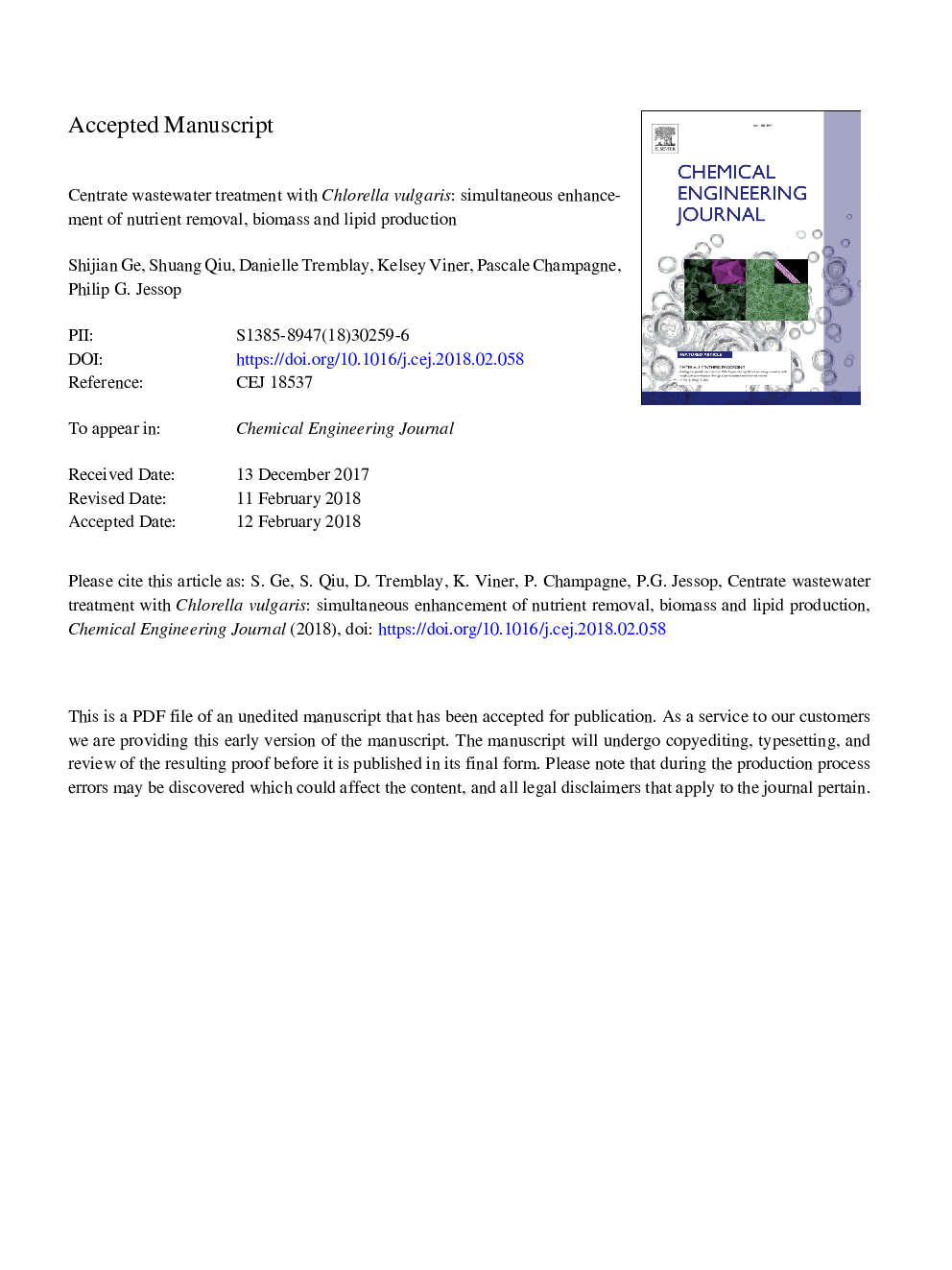| کد مقاله | کد نشریه | سال انتشار | مقاله انگلیسی | نسخه تمام متن |
|---|---|---|---|---|
| 6579766 | 1422936 | 2018 | 37 صفحه PDF | دانلود رایگان |
عنوان انگلیسی مقاله ISI
Centrate wastewater treatment with Chlorella vulgaris: Simultaneous enhancement of nutrient removal, biomass and lipid production
ترجمه فارسی عنوان
تمرکز فاضلاب با کلرلا ولگاریس: افزایش همزمان مواد مغذی، تولید زیست توده و تولید چربی
دانلود مقاله + سفارش ترجمه
دانلود مقاله ISI انگلیسی
رایگان برای ایرانیان
کلمات کلیدی
Secondary wastewaterPBRsC. vulgarisCentrate wastewatersFasHHVPUFAsChlPhotobioreactorsDCWWWTPs - WWTPflame ionization detector - آشکارساز یونیزاسیون شعلهPolyunsaturated fatty acids - اسید چرب اشباع نشدهsaturated fatty acids - اسیدهای چرب اشباع شدهfatty acids methyl esters - اسیدهای چرب متیل استرchemical oxygen demand - تقاضای اکسیژن شیمیاییAuto - خودکارFID - درMicroalgae - ریز جلبک هاChlorophyll - سبزینه یا کلروفیلFAMEs - شهرتWastewater - فاضلاب یا پسابLipid - لیپیدCentrate - متمرکز کردنtotal nitrogen - نیتروژن کاملdry cell weight - وزن سلول خشکoptical density - چگالی نوریCod - کادوgas chromatograph - کروماتوگرافی گازTotal phosphorus - کل فسفرChlorella vulgaris - کلرلا ولگاریسGlycerol - گلیسرول یا گلیسیرینWastewater treatment plants - گیاهان تصفیه پساب
موضوعات مرتبط
مهندسی و علوم پایه
مهندسی شیمی
مهندسی شیمی (عمومی)
چکیده انگلیسی
Achieving high biomass and lipid yields simultaneously during the cultivation process is essential and currently represents one of the biggest challenges in the production of microalgal biofuel. Using waste streams for microalgal growth is essential to improving the economic viability of microalgal biofuel systems, and provides an avenue for wastewater treatment. In this study, the growth of and nutrient removals by Chlorella vulgaris (C. vulgaris) under autotrophic, heterotrophic, and mixotrophic conditions were optimized for centrate wastewater, generated from anaerobic digestion at wastewater treatment plants, as well as on glycerol, a byproduct from the downstream microalgal lipid transesterification process. Compared to autotrophic and heterotrophic conditions, mixotrophic conditions promoted more biomass growth (0.72â¯Â±â¯0.01â¯g/L) and yielded higher total chlorophyll (14.2â¯Â±â¯0.1â¯Âµg/ml) and carotenoid (12.9â¯Â±â¯0.4â¯Âµg/ml) concentrations. Subsequently, three glycerol feeding strategies (single-dose initial feeding, multiple-dose step feeding, single-dose exponential feeding) were studied under mixotrophic conditions. Feeding glycerol at the late exponential growth stage generated the highest biomass (0.070â¯Â±â¯0.001â¯g/L/d) and lipid (20.4â¯Â±â¯3.4â¯mg/L/d) productivities as it engaged both autotrophic and heterotrophic metabolisms, which enhanced biomass yields. The composition of the extracted lipids varied slightly with cultivation conditions, although C16, C18 and C24 accounted for 55-82% of the total fatty acids. Moreover, under conditions exhibiting high biomass production, almost complete nitrogen and phosphorus removals (>99% for both total nitrogen and PO43â-P) were achieved, primarily through biomass assimilation. Finally, an integrated two-phase autotrophic-mixotrophic cultivation process for C. vulgaris, with glycerol fed at the exponential growth stage, was demonstrated, giving an effective wastewater treatment alternative while simultaneously obtaining high lipid productivities for biofuel production.
ناشر
Database: Elsevier - ScienceDirect (ساینس دایرکت)
Journal: Chemical Engineering Journal - Volume 342, 15 June 2018, Pages 310-320
Journal: Chemical Engineering Journal - Volume 342, 15 June 2018, Pages 310-320
نویسندگان
Shijian Ge, Shuang Qiu, Danielle Tremblay, Kelsey Viner, Pascale Champagne, Philip G. Jessop,
